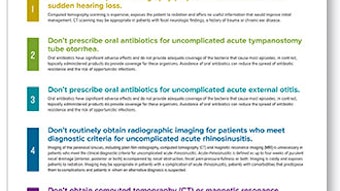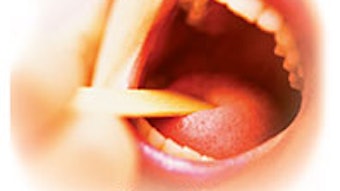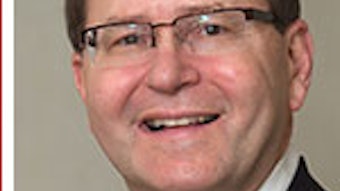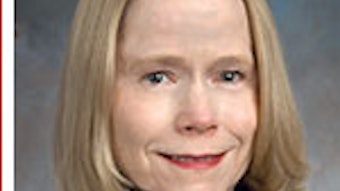Vocal health into the golden years
With advancing age, our voices may sound “old” and weak. This may affect quality of life in many ways. For example, it may be difficult for others, especially those with hearing loss, to hear us, and result in withdrawal. There is sometimes a tendency to think that the undesirable voice qualities associated with older age must be accepted and are an inevitable consequence of aging.
With more people aged 65 and older reporting vocal complaints, here’s what you need to know about treating voice disorders in the elderly
By Karen M. Kost, MD, FRCSC, Westmount, Quebec, Canada
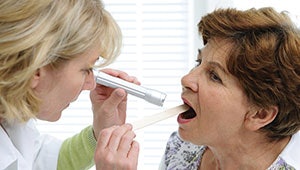
Somewhere between 12 percent and 35 percent of people aged 65 and older have a vocal complaint, which explains the increasing number of consultations for the problem. One-third of those with a vocal complaint use their voices for work, making it an especially high priority. Many patients have both voice problems and hearing loss, resulting in difficulty communicating, and even anxiety and depression.
Voice problems in older people may be due to a variety of conditions including benign lesions, acid reflux, viral laryngitis (usually with a cold-like illness), and neurologic conditions. In addition, there is another condition sometimes referred to as “presbylarynx,” or vocal fold (previously referred to as “vocal cords”) thinning, which occurs more commonly in those older than 65. As you are aware, otolaryngologists diagnose all these conditions based on a thorough history and physical examination. It is not unusual to find more than one problem, for example, vocal fold thinning and acid reflux. Poor health and some medications may also affect the voice adversely.
The more common voice complaints in individuals aged 65 and older include hoarseness, inability to project the voice, throat-clearing, a tired voice, cough, breathiness, and tremor. There also may be reduced range (loss of the highest and lowest notes) and loss of fine control over volume, as well as pitch.
Changes
A number of changes occur in the body with age. All the structures above and below the larynx undergo alterations. The muscles of the face and soft tissues of the mouth and throat become thinner and lose elasticity. The jaw joint becomes stiffer, and the salivary glands produce less saliva. These changes can all affect the ability to eat and swallow, as well as the voice. The lungs, which are the power source of the voice, lose some capacity with age.
The larynx, or “voice box,” also undergoes several changes. Cartilages in the neck become stiffer, as do the cartilages to which the vocal folds are attached. The joints that allow the vocal folds to move may develop some arthritic changes, and the muscles of the vocal folds become thinner. There are several important muscles in the voice box involved in breathing and producing voice. The thyroarytenoid muscle (there is one on each side), often called the vocalis muscle, is involved in several important functions such as respiration, airway protection, and sound production. In addition, it helps modulate pitch and volume, and is important in fine-tuning of the voice. Although it has similarities to other muscles in the body, the vocalis possesses a number of unique structural characteristics such that it is ideally suited for its various tasks. Reduction of overall muscle mass in the body with aging tends to be gradual, and there is little noticeable loss in function until the loss extends beyond threshold levels.
Professor Peter Mueller from Kent State University once said, “The voice is a mirror of personality and senescence may cloud that image.” Older voices often are associated with loss of range and described with undesirable adjectives such as “hoarse,” “raspy,” “breathy,” “unsteady,” “tremulous,” and “shaky.” Indeed, listeners are reasonably accurate in distinguishing between young, middle, and older age groups. In older men the fundamental frequency increases, while in older women, it decreases. The vocal intensity of speech tends to decrease with age, as does the ability to modulate it. For example, it may be difficult to speak “softly.”
Interestingly, these changes are much less apparent, or even absent, in older singers, who may be seen as “exercising” their vocal folds. Older voices often are linked with the perceptual qualities of harshness and roughness. Singers, as well as other healthy, physically fit older individuals, display less harshness and roughness and sound “younger” compared with their counterparts in poor health. Indeed, listeners consistently rate the voices of older singers as “younger” compared to non-singers. A detailed examination of the vocal folds using videostrobolaryngoscopy allows for evaluation of vocal fold vibration, closure, and shape. In patients older than 65, the vocal folds may have a concave edge, and appear thin and bowed. During speech, the vocal folds do not close fully, and the resulting loss of air leads to a weak, “breathy” voice.
Medical treatment
It is well-established that general activity, and in particular exercise programs, positively affect the structure and function of muscle. Resistance training increases muscle mass and strength, while endurance training may help preserve normal muscle structure. At a cellular level, exercise positively affects hormonal levels, and transmission of nerve signals, while blocking the production of destructive chemicals. This suggests that decline is not inevitable and can be minimized or delayed by optimizing health and physical conditioning. Appropriate exercise not only maintains muscle function and coordination, but also improves function of the cardiovascular system, nervous system, and especially the respiratory system, which is so important for optimizing voice quality. Exercise is as important to muscles involved in voice as it is to those elsewhere in the body.
Good oral health is important for maintaining vocal function and includes adequate salivary quality and flow, good dental hygiene, good dentition, and treatment of any mucosal disorders. Many medications are associated with undesirable effects such as cough, drying of the mouth, and slowed mentation, all of which may influence voice negatively. Whenever possible, these medications should be minimized or changed. Acid reflux can affect vocal function negatively, and should be identified and treated.
Hearing loss in the elderly is extremely common, and may result in distortion of pitch and loudness, as well as impaired auditory feedback (the ability to hear one’s own voice), thereby adversely affecting vocal quality and performance. Hearing should therefore be objectively assessed with an audiogram, and hearing impairment should be corrected.
Alterations in mental health, especially memory, and changes in personality secondary to mood disorders and delusionality may impair a person’s ability to concentrate, consistently perform vocal tasks, and cooperate optimally with voice rehabilitation.
Hormonal changes occurring with menopause may result in voice change. Although estrogen replacement may be helpful, the potential associated risks must be considered carefully prior to instituting this therapy. Thyroid hormone disturbances are fairly common in the elderly and can be corrected easily. Even mild hypothyroidism can impair the voice.
In summary, almost all medical conditions may affect vocal quality negatively, and correcting or improving them will directly or indirectly influence vocal performance positively.
In the majority of patients voice exercise programs consisting of traditional voice therapy, singing training, acting voice techniques, and aerobic conditioning are effective in eliminating the characteristics ascribed to an “old” voice. This often involves a team approach, with a speech-language pathologist, acting voice trainer, and singing voice specialists. Acting voice trainers teach techniques not only for development of speaking voice strength and projection, but also for control of face and body function, phonatory expression of emotion, preparation, and interpretation of spoken materials, and other communication skills. Learning these techniques improves not only voice quality and vocal authority, but it also gives the patient great confidence in his/her ability to control vocal communication.
Scientific studies have confirmed the value of voice therapy in the treatment of those with “old” voices. For example, elderly men treated with voice therapy and exercises have significant improvement in the quality and strength of their voices. Studies also have demonstrated that the improvement noted with voice therapy also translates into higher voice-related quality of life scores, a measure of the impact of voice quality on quality of life. It should be noted, however, that voice therapy requires a significant commitment of time, effort, and resources.
Occasionally, medical management alone does not sufficiently restore the voice. In these patients, laryngeal surgery may offer additional benefit. Injection laryngoplasty consists of adding “bulk” to the vocal folds by injecting a material directly into the region of the vocalis muscle. It is a simple, outpatient procedure that improves vocal fold closure. Several safe injectable materials are available. Because most of these materials are absorbed slowly over time, the procedure may need to be repeated. Another appropriate treatment option consists of medializing the vocal folds, or helping them come together by placing an implant through an external incision.
Summary
Dysphonia in geriatric patients is common and is expected to increase as demographics continue to shift to an older population.
The etiology is often multifactorial, with presbylarynx being a diagnosis of exclusion. Older voices are typically hoarse, weak, breathy, unsteady, and tremulous. Examination may reveal prominent vocal processes, atrophic vocal folds, and a spindle-shaped glottic gap. Presbyphonia is associated with depression, anxiety, social isolation and a reduction in quality of life. Histological changes have been demonstrated in the mucosa, lamina propria, and musculature of aged vocal folds. Similar age-related changes in limb skeletal muscles of elderly patients occur as well. Convincing evidence has shown that many of these changes can be reversed or avoided with maintenance of good general health and conditioning, which is maintained with regular physical exercise.
Older singers are perceived to have younger voices compared to elderly non-singers, presumably because of the benefits of regular vocal exercise. With optimal physical and vocal conditioning, proper medical supervision of cardiac and respiratory function, and appropriate medication, weight control, nutrition, and surgery in selected cases, many singers, actors, clergy, politicians, teachers, and others may enjoy extra years or even decades of improved voice performance. Voice exercise programs in elderly patients with age-related dysphonia provide an effective and non-invasive means of treatment, with a positive influence on quality of life, as well as improvement in acoustic measures, maximum phonation time, and vocal intensity. In selected patients with insufficient improvement from medical therapy, surgery often provides added benefit.
The AAO-HNS Geriatric Otolaryngology Committee, Alan Rubin, MD, Chair, and Robert T. Sataloff, MD, former Chair, enlisted ORL-HNS experts to address many of the age-related conditions that Academy Members see when treating aging patients. The result is a new clinical book for otolaryngologists on its way to members via Thieme publishers this spring. However, the committee has also authored a patient-facing series of articles, directed to primary care physicians and patients to heighten understanding of ear, nose, throat, head, and neck issues related to aging that might require a specialist’s care. So, in keeping with this issue’s theme, Dr. Kost developed the preceding on voice.
